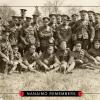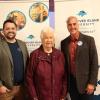January 12, 2010 - 5:09am
Two faculty members at Vancouver Island University have discovered a unique way to create better learning experiences for students.
Media Studies instructor Doug Stetar and English teacher Daniel Burgoyne collaborated on a pilot project linking two courses – English 115 (university writing and research) and Media Studies 112 (popular culture).
The interdisciplinary experiment aimed at first year students was a huge success, surpassing expectations. “We found that our students wrote better essays, were able to speak at a more engaged and sophisticated level in class and overall achieved higher grades,” said Stetar.
“This is a great example of faculty working across disciplines to create innovative learning experiences for students,” said VIU President Dr. Ralph Nilson. “We consistently receive feedback from our students that they value this type of dedication by our faculty. It helps set VIU apart as a great undergraduate university.”
Burgoyne and Stetar, both long-time faculty members, came up with the idea to improve learning for students and keep their teaching fresh and inspiring.
They spent hours developing the shared course curriculum, combining content from Stetar’s class – an introduction to culture and media – and integrating it with Burgoyne’s material on writing and composition. Students received credit for both courses.
Typically university courses are separate units that rarely relate to one another, said Stetar. “Often students don’t see the whole meal. They see each class as an individual appetizer.”
“In this case, the writing assignments in my English 115 class supplemented the work going on in Doug’s Media Studies class,” added Burgoyne. “Doug asked the students to read the textbook material. I asked them to write about it.”
The result provided students with greater skill sets and taught them to think holistically about writing and how it is integral to all academic disciplines.
“Combining classes creates a meaningful connection for students,” said Stetar. “They see the broader picture and how their studies relate. The feedback we’ve received is positive. Students are excited and hungry for this type of education.”
“I have been a big fan of this kind of course design ever since I worked on a nine-credit interdisciplinary package we called ‘Connections’ back in 1991-93,” said Steve Lane, Dean of Arts and Humanities. “With a bit of extra work by the faculty to explore meaningful ways to integrate the courses, there are, I believe, big payoffs for the students. Now that I am an administrator, my job is to encourage this kind of collaboration and, where faculty want to try it out, make sure the administrative structures to support them are in place.”
Burgoyne and Stetar said the process was a valuable learning experience for them professionally. “It’s like going to a conference where you come back feeling recharged and reconnected,” said Stetar. “It’s given me a fresh perspective towards teaching, and reminded me again that to learn is to take risks.
“Developing ways to improve the learning environment is the backbone of what VIU is all about because of our history and our focus,” said Stetar. “As a small institution that is focused on excellence in teaching, it’s nice to see that faculty are encouraged to interact, connect and create interdisciplinary experiences for students.”
With minor fine-tuning, Burgoyne and Stetar plan to offer the combined classes to first-year students next fall. “We’d love to see another full class,” said Burgoyne. “It would lead to even more innovation in teaching.”
For more information about the Media Studies and English 112 pilot project, contact Doug.Stetar@viu.ca orDaniel.Burgoyne@viu.ca.
Tags: In the Community






